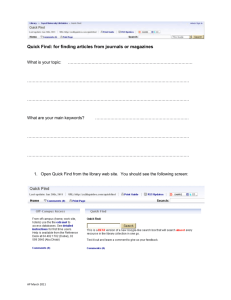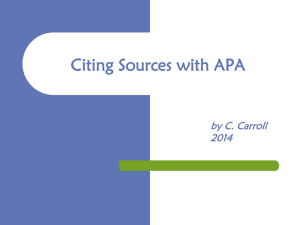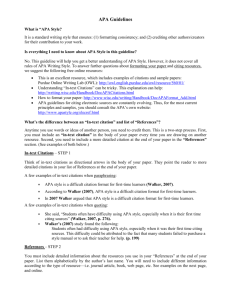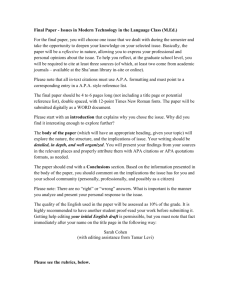APA In-Text Citation Guide: Format & Examples
advertisement
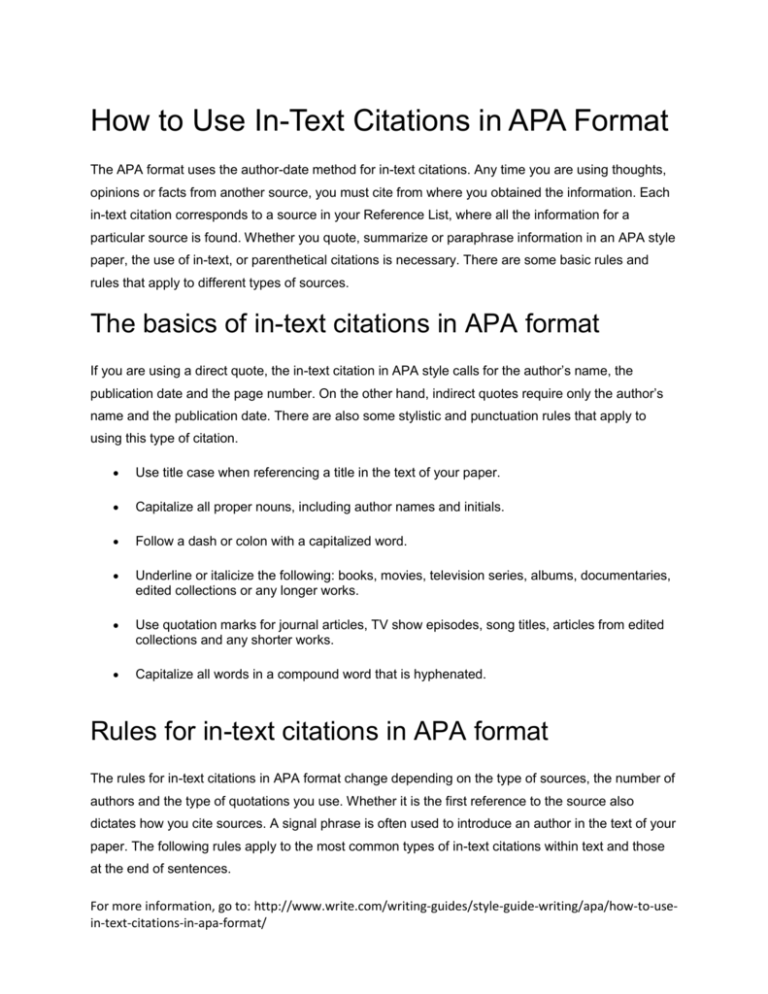
How to Use In-Text Citations in APA Format The APA format uses the author-date method for in-text citations. Any time you are using thoughts, opinions or facts from another source, you must cite from where you obtained the information. Each in-text citation corresponds to a source in your Reference List, where all the information for a particular source is found. Whether you quote, summarize or paraphrase information in an APA style paper, the use of in-text, or parenthetical citations is necessary. There are some basic rules and rules that apply to different types of sources. The basics of in-text citations in APA format If you are using a direct quote, the in-text citation in APA style calls for the author’s name, the publication date and the page number. On the other hand, indirect quotes require only the author’s name and the publication date. There are also some stylistic and punctuation rules that apply to using this type of citation. Use title case when referencing a title in the text of your paper. Capitalize all proper nouns, including author names and initials. Follow a dash or colon with a capitalized word. Underline or italicize the following: books, movies, television series, albums, documentaries, edited collections or any longer works. Use quotation marks for journal articles, TV show episodes, song titles, articles from edited collections and any shorter works. Capitalize all words in a compound word that is hyphenated. Rules for in-text citations in APA format The rules for in-text citations in APA format change depending on the type of sources, the number of authors and the type of quotations you use. Whether it is the first reference to the source also dictates how you cite sources. A signal phrase is often used to introduce an author in the text of your paper. The following rules apply to the most common types of in-text citations within text and those at the end of sentences. For more information, go to: http://www.write.com/writing-guides/style-guide-writing/apa/how-to-usein-text-citations-in-apa-format/ One author Signal phrase : Stans (2010) found… Parenthetical citation: (Stans, 2010). Two authors Signal phrase: Stans and Jubina (2010) found… Parenthetical citation: (Stans and Jubina, 2010). Three, four or five authors Signal phrase first use: Coles, Burns, and Kopens (2010) found… Signal phrase subsequent use: Coles et al. (2010) found…. Parenthetical citation first use: (Coles, Burns, & Kopens, 2010). Parenthetical citation subsequent use: (Coles et al., 2010). The same format shown for three authors is used for four and five authors. Simply list the authors, separated by a comma, with either “and” (for references in text) and “&” (parenthetical format at end of sentences) and the final author’s name. Six or more authors Signal phrase: Burns et al. (2010) found… Parenthetical citation: (Burns et al., 2010). Anonymous author If the author of a work is listed as “Anonymous,” use it as the author’s name in a parenthetical citation. Parenthetical citation: (Anonymous, 2009). For more information, go to: http://www.write.com/writing-guides/style-guide-writing/apa/how-to-usein-text-citations-in-apa-format/ Organization as an author When the author of a source is a government agency or organization, use the agency or organization name. Signal phrase: The Federal Trade Commission (2011) found… Parenthetical citation: (Federal Trade Commission, 2011). If an abbreviation is commonly used to refer to a well-known organization, use the abbreviation and the full name in the first in-text citation in APA format, and use only the abbreviation in subsequent parenthetical citations. First in-text citation: (Federal Bureau of Investigation [FBI], 2009). Subsequent in-text citations: (FBI, 2009). No author If the work you are citing does not have an author, use the title. If you are using a signal phrase, use the entire title name. Underline or italicize books and reports; put titles of chapters, websites and articles in quotations. If you are using a parenthetical citation, use the first word or two of the title. Two authors, same last name When two works have authors with the same last name, include the first initial of each author’s first name. Parenthetical citation: (B. Coles, 2010; F. Coles, 2008). One author, two or more works with same publication year When two or more works by the same author have the same publication year, use lowercase letters to show that they are two separate sources. The lowercase letters (a, b, c, etc.) are used with the year. For more information, go to: http://www.write.com/writing-guides/style-guide-writing/apa/how-to-usein-text-citations-in-apa-format/ Signal phrase: Coles (2010a) found… o Coles (2010b) found… Parenthetical citation: (Coles, 2010a; Coles, 2010b). Two works, one in-text citation When citing two separate sources for the same information, include both works in the in-text citation, and use the same order in which the works appear in your Reference List. Separate the works with a semicolon. Parenthetical citation: (Coles, 2010; Darnol, 2007). Indirect sources When you are citing information that is cited in one of your sources, you need to use both the original source author’s name and the cited source information. Use a signal phrase to mention the original author’s name, and use a parenthetical citation to show the secondary source. However, when possible, you should aim to find and use the original source. Example: Kent proposed…(as cited in Coles, 2010). Electronic sources Electronic sources are cited in the same way as print sources when page numbers are available. However, when using in-text citations in APA format for internet and other multimedia sources where page numbers are not available, use other information that notes the location of where you pulled the information. Use the screen number, the section (sec.), the paragraph (para.), the time frame (minute or second) or track. This information replaces the page number in the parenthetical citation in APA format. Works with no publication dates When there is no publication date listed, use “n.d.” to notate this. This is commonly found with internet sources, and in many cases, no author is listed either. For more information, go to: http://www.write.com/writing-guides/style-guide-writing/apa/how-to-usein-text-citations-in-apa-format/ Signal phrase: In “The Basics of Web Design,” it is argued…(“The Basics,” n.d.). Parenthetical citation: (“The Basics,” n.d.). Multivolume Works For in-text citations for multivolume works, include the volume number in the parenthetical citation after the year of publication. If a page number is necessary, offset the volume number with a comma. Example: (Coles, 2010, vol. 3, p. 34). Personal communications Sometimes you may need to cite an email, interview, letter or another form of interpersonal communication. While this is not included in your Reference List, it is necessary to cite the name of the communicator, the date the communication took place and that it is a personal communication. Signal phrase: Kent stated that he believed this was false, however (personal communication, January 12, 2009). Parenthetical citation: (Kent, personal communication, January 12, 2009). Referencing page numbers When a direct quotation is used, the page number is included in the in-text citations in APA format regardless of the number of authors or type of source. A comma separates the year of publication and the page number. Signal phrase: Coles (2010) found… (p. 35). Parenthetical citation: (Coles, 2010, p. 35). Indirect quotations do not require the inclusion of a page number. For more information, go to: http://www.write.com/writing-guides/style-guide-writing/apa/how-to-usein-text-citations-in-apa-format/

